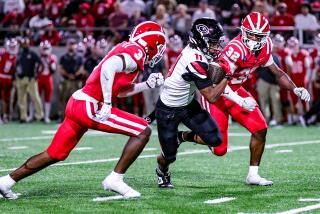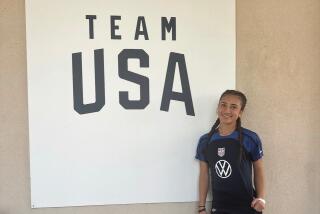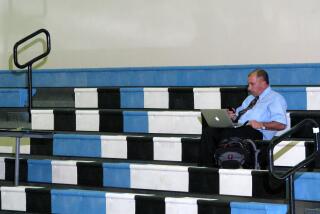College Catalog : Granada Hills Scout Rates Football Prospects to Provide Shopping Assistance by the Numbers
Foster Andersen at a high school football game: He draws a bead on an offensive lineman’s feet. Are they quick feet? Or slow feet? Then he focuses on a defensive back’s hips. How fast can they switch gears from forward to reverse? Next, he zeroes in on a receiver’s hands. Soft or hard? And the quarterback’s arm. How strong?
To Andersen, winning isn’t everything, anatomy is. Every week during the football season, he sees a minimum of 3 high school and 2 junior college games. He doesn’t care about results. He doesn’t root. He just scrutinizes hands and feet and hips and arms and puts all the body parts together to form a well-rounded opinion of a player.
As the owner of Sports Search, a scouting service he runs out of his Granada Hills home, Andersen judges football prospects and sells his evaluations to major colleges such as USC, UCLA and Miami.
This past season, he and 2 associates analyzed the college potential of 400 high school and 400 junior college players in the vast football caldron of Southern California. That’s a lot of body parts.
“But I never get tired of going to games,” says Andersen, 48, a two-way lineman for UCLA in the early 1960s and former head coach at Cal State L. A. “It’s the parking that bugs me.”
Scouting services such as Andersen’s are in vogue--USC subscribes to about 50--because the NCAA has tightened the screws on recruiting. As of this year, colleges cannot even scout a prospect until Nov. 1. To cover ground quickly and thoroughly, they buy reports from scouting services, which rate the best players. Andersen sells his service for as much as $800 a year for voluminous compilations or as little as $75 for, say, a breakdown on quarterbacks.
“Our reports allow a college staff to prioritize its time,” Andersen says. “We tell them who they should concentrate on and who’s a waste of time.”
The fear of missing a blue-chip player also drives colleges to subscribe to scouting services. “We cross-reference players rated by the various services,” says USC recruiting coordinator Jack Himebauch.
Andersen assigns a rating to each player he scouts. The best is a 1+, which represents “the guys I’d want if I were coach at USC or UCLA,” he says. Players rated as a 1 or 1- are Division I caliber. A 2+ would be the best player available for Division II schools. Of the 400 high school players he has evaluated this year, “150 are capable of playing in Division I and maybe 30 are rated 1+,” he says.
But his ratings are not chiseled in stone. Colleges use scouting services as an aid, not a directive, often disagreeing with or ignoring their recommendations. “Coaches still make their own evaluations,” Himebauch says. “They don’t rely on somebody else’s opinion to offer a player a scholarship.”
Last year, Andersen says he was pushing Jack Swan of El Camino Royal High as “the best offensive lineman in the Valley.” But neither USC nor UCLA recruited him, Andersen says, because at 6-3, he was shorter than their prototype lineman. But one of Sports Search’s subscribers, the University of Georgia, gave Swan a scholarship and “think they stole him out of Southern California,” Andersen says.
Andersen puts all his information in an IBM computer in the family room of his ranch house. Players are listed alphabetically and by position. Aside from ratings, Andersen includes capsule comments on each player, “little bits of information coaches like.” Typing on the computer keyboard--”I had to learn to type to go into this business,” he says--Andersen called up Hart High tight end Brian Allen. The comment read:
“Catches with hands. Doesn’t look like he’ll fill out for different positions because of body type.”
Andersen explained, “Coaches don’t necessarily like receivers who catch the ball against their pads, and they also want to know if a prospect has the potential to play other positions,” such as offensive or defensive line.
In the analysis of Crespi running back Russell White, Andersen mentioned that he could also be “a great defensive back.” White, of course, got Andersen’s highest rating despite nagging injuries and a “weak offensive line” this season. “I watched him in practice,” Andersen says, “and his work ethic is very, very good.”
But who is the best back in the L. A. area? Andersen likes Hawthorne quarterback Curtis Conway, projecting him as a college tailback. Andersen’s computer comment says Conway “may be the next Marcus Allen.”
An assistant coach at USC under Ted Tollner, Andersen was out of a job when Larry Smith brought in his own assistants 2 years ago. So Andersen, along with computer expert Dick Laugens, started Sports Search, hiring former USC assistants Larry Bryan and Nate Shaw to help with the scouting. They specialize in Southern California players “because California supplies 15% of the players in Division I,” Andersen says.
Andersen has opinions on where to find the best players in the area. “Banning and Carson have the premier concentration of athletes in public schools,” he says. “In private schools, it’s Loyola and Crespi. They have good coaches and an administration that wants football to be a unifying force on campus.”
Andersen says that San Fernando High has the best talent in the Valley this year and Orange County “is where you’ll find the great linemen.” Inner-city schools, he says, “traditionally produce great running backs and receivers.”
Andersen sometimes disagrees with all-star teams, which he says are based on “politics.” For instance, the Golden League put defensive lineman Sean McCune of Canyon High on its second team. “I think he’d leave some of the first team in the dirt,” Andersen says. He gave Granada Hills defensive lineman Anthony Hall a 1+ but Hall didn’t make All-North Valley League.
Although the 1988 season is behind him, Andersen will not be taking it easy until the fall.
Scouting is a full-time, year-round job. “We’re working on our spring list--juniors in high school,” he says. So he will be attending spring practices--and watching lots of body parts.
More to Read
Get our high school sports newsletter
Prep Rally is devoted to the SoCal high school sports experience, bringing you scores, stories and a behind-the-scenes look at what makes prep sports so popular.
You may occasionally receive promotional content from the Los Angeles Times.






